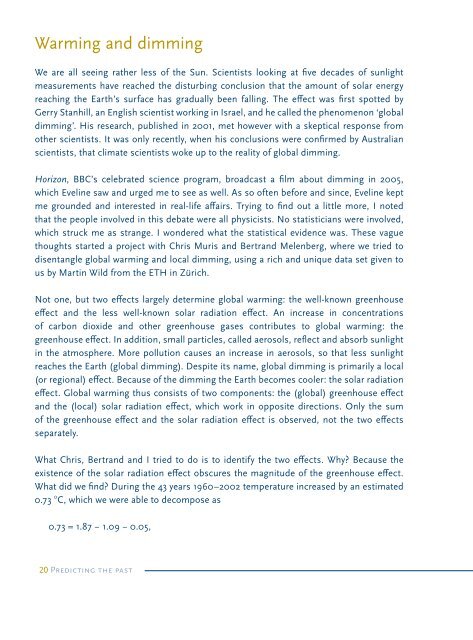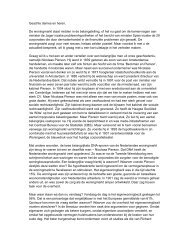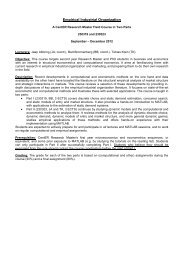Predicting the past - Tilburg University, The Netherlands
Predicting the past - Tilburg University, The Netherlands
Predicting the past - Tilburg University, The Netherlands
You also want an ePaper? Increase the reach of your titles
YUMPU automatically turns print PDFs into web optimized ePapers that Google loves.
Warming and dimming<br />
We are all seeing ra<strong>the</strong>r less of <strong>the</strong> Sun. Scientists looking at five decades of sunlight<br />
measurements have reached <strong>the</strong> disturbing conclusion that <strong>the</strong> amount of solar energy<br />
reaching <strong>the</strong> Earth’s surface has gradually been falling. <strong>The</strong> effect was first spotted by<br />
Gerry Stanhill, an English scientist working in Israel, and he called <strong>the</strong> phenomenon ‘global<br />
dimming’. His research, published in 2001, met however with a skeptical response from<br />
o<strong>the</strong>r scientists. It was only recently, when his conclusions were confirmed by Australian<br />
scientists, that climate scientists woke up to <strong>the</strong> reality of global dimming.<br />
Horizon, BBC’s celebrated science program, broadcast a film about dimming in 2005,<br />
which Eveline saw and urged me to see as well. As so often before and since, Eveline kept<br />
me grounded and interested in real-life affairs. Trying to find out a little more, I noted<br />
that <strong>the</strong> people involved in this debate were all physicists. No statisticians were involved,<br />
which struck me as strange. I wondered what <strong>the</strong> statistical evidence was. <strong>The</strong>se vague<br />
thoughts started a project with Chris Muris and Bertrand Melenberg, where we tried to<br />
disentangle global warming and local dimming, using a rich and unique data set given to<br />
us by Martin Wild from <strong>the</strong> ETH in Zürich.<br />
Not one, but two effects largely determine global warming: <strong>the</strong> well-known greenhouse<br />
effect and <strong>the</strong> less well-known solar radiation effect. An increase in concentrations<br />
of carbon dioxide and o<strong>the</strong>r greenhouse gases contributes to global warming: <strong>the</strong><br />
greenhouse effect. In addition, small particles, called aerosols, reflect and absorb sunlight<br />
in <strong>the</strong> atmosphere. More pollution causes an increase in aerosols, so that less sunlight<br />
reaches <strong>the</strong> Earth (global dimming). Despite its name, global dimming is primarily a local<br />
(or regional) effect. Because of <strong>the</strong> dimming <strong>the</strong> Earth becomes cooler: <strong>the</strong> solar radiation<br />
effect. Global warming thus consists of two components: <strong>the</strong> (global) greenhouse effect<br />
and <strong>the</strong> (local) solar radiation effect, which work in opposite directions. Only <strong>the</strong> sum<br />
of <strong>the</strong> greenhouse effect and <strong>the</strong> solar radiation effect is observed, not <strong>the</strong> two effects<br />
separately.<br />
What Chris, Bertrand and I tried to do is to identify <strong>the</strong> two effects. Why? Because <strong>the</strong><br />
existence of <strong>the</strong> solar radiation effect obscures <strong>the</strong> magnitude of <strong>the</strong> greenhouse effect.<br />
What did we find? During <strong>the</strong> 43 years 1960–2002 temperature increased by an estimated<br />
0.73 0 C, which we were able to decompose as<br />
0.73 = 1.87 − 1.09 − 0.05,<br />
20 <strong>Predicting</strong> <strong>the</strong> <strong>past</strong>









